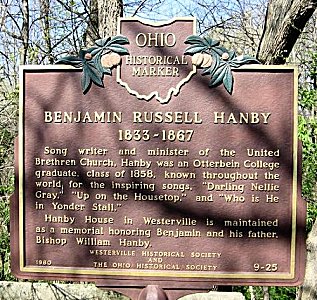Introduction

Born: July 22, 1833, Rushville, Ohio.
Died: March 16, 1867, Chicago, Illinois, of tuberculosis.
Buried: Otterbein Cemetery, Westerville, Ohio.


Born: July 22, 1833, Rushville, Ohio.
Died: March 16, 1867, Chicago, Illinois, of tuberculosis.
Buried: Otterbein Cemetery, Westerville, Ohio.

Benjamin was the son of United Brethren minister (and later bishop) William Hanby and Ann Miller, and husband of Mary Kathryn Winter.
He attended Otterbein University in Westerville, Ohio. Upon graduation, he worked for the college, then served as principal of an academy in Seven Mile, Ohio.
He later served pastorates in Lewisburg and New Paris, then worked for music publishers John Church (Cincinnati, Ohio) and Root & Cady (Chicago, Illinois).
Hanby’s father was active in the Underground Railroad, and was trying to raise money to free Selby’s beloved.
Hanby wrote over five dozen songs, many of which appeared in the quarterly Our Song Birds.
One of his best known secular songs is Darling Nelly Gray (🔊 PDF NWC). He wrote the song while attending Otterbein College, in response to the plight of a runaway slave named Joseph Selby (or Shelby).
In 1864, in New Paris, Ohio, Hanby wrote Up on the Housetop, said to be the second oldest secular Christmas song (preceded only by Jingle Bells), and the first to suggest that Santa Claus’ sleigh landed on house roofs.
His other works include: